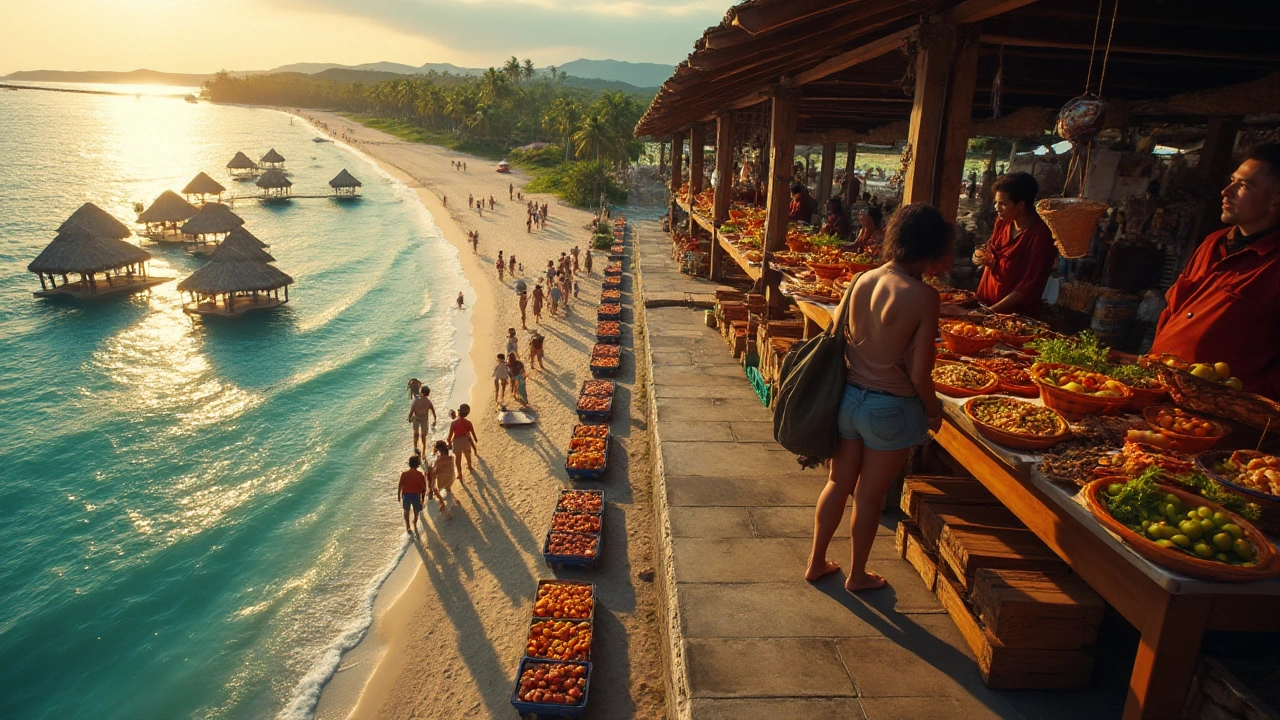When planning a holiday, the allure of all-inclusive packages can be irresistible. They promise a worry-free escape from the daily grind, bundling everything from accommodations to meals into one tidy, often affordable, package. But, like most things that seem too good to be true, these packages have shortcomings that are worth considering before you book.
Travelers often dream of immersive cultural experiences, yet these are sometimes limited when staying at an all-inclusive resort. The very convenience they offer can also mean cutting you off from the vibrant local culture littered just beyond resort boundaries. As we journey into this topic, let's uncover the nuances of what it means to choose an all-inclusive package.
- Limited Local Culture Exposure
- Hidden Costs and Fees
- Reduced Culinary Adventures
- Overcrowding and Rigid Schedules
- Environmental Concerns
Limited Local Culture Exposure
Diving into an all-inclusive vacation might initially sound like the perfect antidote to workaday stress. One sign-up, and your meals, drinks, and activities are bundled together, removing the need for daily decision-making. However, this very aspect can inadvertently place a barrier between travelers and the enriching experiences offered by local culture. For those seeking an authentic gustatory delight in the markets of Marrakech or a tranquil siesta on a lesser-known Caribbean beach, the all-inclusive experience can sometimes feel constraining. It is precisely this sense of enclosure that might prevent travelers from engaging fully with the unique heritage lingering just beyond the resort gates. Wandering through bustling local marketplaces or sharing a laugh with a street vendor can forge memories unique to a locale, but these experiences often require voyaging beyond perimeters defined by pre-packaged trips.
Known fact: several studies, including one by the World Tourism Organization, have found that cultural tourism can significantly enrich and support local economies. Yet, staying within the confines of an all-inclusive resort often limits one's chances to partake in this sustainable exchange. Such packages may, indeed, save you an unpredictable dinner bill. Still, they'd inadvertently close the doors on quaint family-owned eateries lining the cobbled streets of centuries-old towns, adorned with local artworks and infused with regional aromas. Stepping outside of an all-inclusive haven can often elevate a trip from tranquil to transformative.
According to Anthony Bourdain, 'Travel changes you. As you move through this life and this world you change things slightly, you leave marks behind, however small. And in return, life and travel leave marks on you.' A quote like this epitomizes the depth of cross-cultural interaction that can be missed when staying segregated within one compound.
Moreover, a dedication to exploring cultural nuances can introduce surprising delights—from witnessing traditional dances invigorated by native musicians to participating in village festivals that celebrate historical triumphs and tribulations. Those opting for an all-inclusive experience, while never leaving hotel grounds, might only observe these wonders from afar, possibly on a television in their air-conditioned room. To get the full symphony of colors, sounds, and tastes an area has to offer, it often helps to venture into the heart of it, escaping the conventional offerings of resorts. For many, choosing to engage with local culture is an indispensable facet of the journey, establishing a profound connection to the world outside familiar comfort zones.
Hidden Costs and Fees
All-inclusive packages are cherished for the convenience they promise. They create an image of stress-free vacations where you leave your wallet behind, knowing everything is already taken care of. However, what's often left unsaid are the potential hidden costs and fees that can catch travelers off guard. From unexpected services to mysterious taxes, these hidden charges can quickly turn a budget-friendly trip into a costly affair. It's crucial to scrutinize what your package truly includes and what might incur additional costs, such as premium drinks or off-resort excursions.
While some packages offer a wide range of included beverages, often, top-shelf spirits carry an extra charge. The same can go for certain specialty meals, such as dining in a high-end resort restaurant, which can be surprisingly excluded from the package. Travelers may presume their package encompasses all dining options on-site, but it's best to confirm this detail. Non-motorized water sports might be included, whereas jet skis and parasailing can be notably expensive and exclusive.
Resort fees are another cost travelers might encounter. Though less prevalent today, some resorts still tack on daily fees that encompass amenities like Wi-Fi, gym usage, or spa access, surprisingly adding to what was presumed to be an all-inclusive rate. Moreover, tipping policies can vary widely. Some resorts incorporate gratuities into their pricing, while others expect travelers to tip for daily services separately. It’s imperative to ask and verify what's customary at your selected destination to avoid any awkward surprises.
"Fees are often designed in such a way that travelers don't notice them until they check out, and that's the reason they exist," says a travel consultant, emphasizing the importance of vigilance.
Another expense that vacationers might not anticipate is associated with childcare services. Many family-friendly resorts tout their childcare options, but some of these come with usage fees, particularly for babysitting services or special kids' activities. It's essential for families to verify these details, particularly if traveling with young children. While the kids enjoy a day at the beach or swimming in the pool, parents might unknowingly be racking up a larger bill.
Seasonal prices can alter costs too, as high-demand periods might lead to discrepancies in what's covered. This is sometimes reflected in increased airfares—especially if flights are bundled with the package—and limited availability for discounted tours. To ensure your vacation planning remains stress-free, vigilance is key when examining the fine print of your package.

Reduced Culinary Adventures
Embarking on an all-inclusive trip often means giving up the chance to explore the culinary landscape of your destination. While it's incredibly convenient to have meals prepaid and at your fingertips, this can limit the range of flavors and experiences you've imagined when dreaming about exotic locales. When guests opt for all-inclusive packages, they frequently find themselves eating within a resort's confines, often at the same few restaurants throughout their stay. These establishments aim to cater to a broad audience and, as a result, tend to lean towards a safer, more familiar menu lineup that risks lacking the authenticity and excitement found in local eateries and street food.
Most all-inclusive resorts focus on international cuisine standards – think endless buffets with melding flavors and pile-high pasta stations – rather than showcasing traditional dishes. This means that a Spanish getaway might surprise you with pizza and burgers instead of a richly flavorful paella or fresh tapas. The culinary monotony may turn what could be a gastronomic adventure into a blur of cuisines designed more with comfort in mind than cultural storytelling. This culinary dilution is a common sentiment echoed by travelers in forums, underscoring the importance of considering what you'll potentially be missing out on when choosing this travel style.
Financially, reduced culinary adventures might sound appealing, especially when meals are seemingly 'free.' However, as some critics have pointed out, these meals are not free of cost but part of what's paid upfront. "In places like Thailand, where street food is an integral part of the culture, not venturing out can mean missing out," suggests travel food writer Emily Becker. She shares in one of her acclaimed articles how travelers might unknowingly sacrifice vibrant, exploratory experiences for the predictability offered by resort menus, which can often be disappointing. After all, delighting in a country’s specialty dishes at a bustling local market or fishing village can be an unforgettable part of the journey.
For those who deeply care about food, leaving the nest of an all-inclusive resort might be a necessity to savor truly local dishes. Consider the energetic food stalls in Mexico City or the delicate sashimi spots in Tokyo, which all-inclusive dining simply cannot compete with on an authentic culinary level. As you weigh the pros and cons of all-inclusive vacations, think about how much culinary exploration matters to you. If trying new foods and diving into local gastronomic scenes give life to your travel plans, don't let a potentially lackluster culinary offering bear too strongly on your choice. It might be worth paying extra to truly indulge your senses and fully embrace the heart of local dining culture from your trip.
All-inclusive packages might suffice for keeping you fed, but they often don't fuel the hunger for genuine connection and discovery that can be deeply satisfying parts of traveling. An open mind, a little courage, and a willingness to venture beyond resort walls can enrich your travel experience tenfold, offering stories and flavors that last a lifetime. Travel with the curiosity that drives deeper understanding, and you may find culinary explorations to be the secret spice that makes your journeys truly extraordinary.
Overcrowding and Rigid Schedules
One of the oft-encountered realities at all-inclusive packages is the marred experience of overcrowding. Imagine arriving at the resort, stress-free, only to find yourself in a sea of people swarming around the pool, dining areas, and bars. Since these resorts are designed to maximize guest occupancy for profitability, large numbers of guests can crowd the space, potentially leading to long waits for amenities. At times, this factor can drain the serene ambiance travelers crave. The feeling of exclusivity is sometimes lost, battling lines and crowded hotspots rather than unwinding in peace.
Rigid schedules pose an added layer of constraint to these vacays, often whipping up an unexpected test to flexibility. Meal times, organized activities, and entertainment often follow strict timetables. This can strip spontaneity from your days as every activity is generally pre-planned, and anything outside the scheduled list might incur extra costs. These tightly packed schedules may not resonate with travelers yearning for leisurely laid-back time—sometimes, the appeal of doing nothing can be the most fulfilling. For family travelers with children, like mine, who might not adhere to the preset timelines, it can become challenging catering to the fixed itineraries.
"The increasingly complex and crowded nature of all-inclusive experiences has muted their allure for free-spirited travelers," suggests travel consultant Nicholas Westin, who has spent over two decades observing holiday trends.For travelers who appreciate a more intimate and uncrowded environment, considering the off-season travel windows might reduce the crowd density. Look for resorts that market themselves as boutique or smaller-scale, which often offer a more serene and personalized experience. This doesn’t mean they lack charm—some smaller resorts can surprise with their tailored amenities and personalized services, offering a breath of fresh air to counter the crowded scenarios larger all-inclusives present. These considerations ensure travelers can balance the pros of the all-inclusive model while minimizing the typical drawbacks of packing into these vacation hubs.
Measuring the benefits of vacation planning that provides fixed schedules against flexibility, stagger your days to include downtime from the structure. Wise travelers often carve out personal exploration slots in their itineraries, venturing beyond resort walls to mingle with the local environment. Exploring the territory beyond those boundaries can not only serve as a refuge from the resort bustle, but can also turn your trip into a cherished memory that reflects the heart of your destination's unique culture. Remember, not all that is set in the diaries of resort life has to be followed like gospel—go beyond when needed for a truly balanced experience.

Environmental Concerns
All-inclusive resorts, while convenient, often have complex relationships with the environments in which they thrive. Their allure, which promises unlimited drinks and round-the-clock food, translates to massive resources being consumed on a daily basis. Resorts are notorious for their high water and energy needs, which can strain local supplies and impact the surrounding ecosystems adversely. The environmental footprint of such accommodations isn’t limited to resource consumption either; waste management is a significant issue. Tons of plastic, food waste, and other non-recyclables often end up improperly disposed of, posing a threat to local wildlife and marine habitats.
Consider the construction of these resorts, which often require significant land alteration, leading to habitat destruction and biodiversity loss. Particularly in coastal areas, the damage can include the destruction of coral reefs and mangroves, essential ecosystems for marine life. Travel drawbacks like these can hamper not only the local wildlife but also contribute to larger environmental disruptions like beach erosion and increased carbon footprints. These natural assets, once lost, may not be easily or ever fully restored. The responsibility falls not just on the resorts, but on travelers too. Conscious choices can drive demand for more sustainable practices within the industry.
Local Impact and Community Involvement
Unfortunately, all-inclusive packages often create economic bubbles that do not significantly benefit the surrounding communities. Located in isolated pockets, they tend to sequester tourists away from local businesses. This model leads to limited economic spillover and can sideline local vendors, restaurants, and artisans. In many cases, resources that could contribute directly to local development are funneled solely into resort operations. The disparities are further pronounced when local labor is underpaid or hired as seasonal workers with little opportunity for career growth.
Striving for eco-friendly advancements, several resorts have turned towards more sustainable practices, offering eco-tours and workshops that engage guests in environmental conservation efforts. A growing trend among the younger generation of travelers, this shift indicates a demand for authentic experiences that contribute positively to the environment. As a hopeful sign, when tourists actively seek places with good environmental practices, they drive vital change. If you are among those who wish to see more of this change, keep an eye out for resorts with transparent sustainability policies.
"Sustainable tourism needs to be the new norm, not the exception," says Dr. Emily Riley, an environmental economist. "We have the power as consumers to demand better and in turn, ensure these beautiful destinations can be enjoyed for generations to come."
If you want practical ways to travel responsibly while still enjoying the amenities and ease of an all-inclusive, consider prioritizing resorts that are Green Key certified or similar. Such certifications indicate a commitment to reducing environmental impact and often involve measures such as renewable energy use, water recycling, and community investment. Yet, certified or not, the choices travelers make can ripple outward. Even small actions, like minimizing waste during your stay or opting into offset programs, can collectively ease the burdens on beloved locations.
